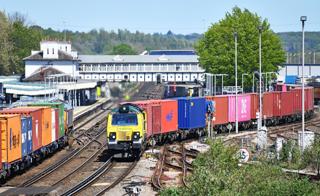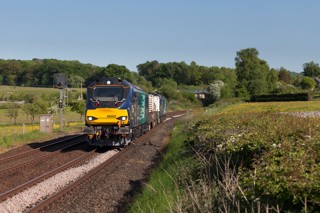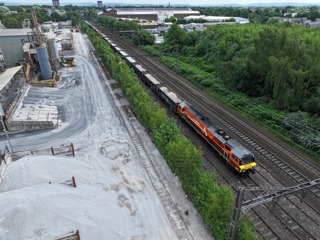An intended reorganisation of local government that includes an increase in the number of elected Mayors is likely to improve the delivery of local rail services and bring proposals for new services.
A two-stage process is to take place, with unitary authorities merging the existing responsibilities of county and district councils, and creating mayoral boundaries that combine these authorities.
An intended reorganisation of local government that includes an increase in the number of elected Mayors is likely to improve the delivery of local rail services and bring proposals for new services.
A two-stage process is to take place, with unitary authorities merging the existing responsibilities of county and district councils, and creating mayoral boundaries that combine these authorities.
For example, in the case of Norfolk, which is likely to have three unitary bodies, there would be a single elected mayor with responsibility that includes separately funded projects for integrated public transport.
It is widely accepted that in markets such as local transport, decisions are best made by funding bodies that are closest to users, to understand what the demand might be rather than depend on forecasting models based on economic assumptions.
The steady stream of line reopenings promoted by devolved governments and local authorities has, in nearly every case, resulted in a substantial underestimate of the demand that emerges once services start. This has been the experience for the Borders Railway to Tweedbank, and for the Ebbw Valley line.
A common factor in creating demand is the loss of employment in local communities, which for the Borders Railway reflected the decline of the woollen industry, and for communities served by the Ebbw Vale route the closure of coal mines and steel works.
The current reopenings to Ashington and Levenmouth repeat much of this experience, with a need within the communities served to access employment and educational opportunities.
There is also the bigger picture of action to reduce city centre road congestion and poor air quality, so as well as generating new journeys, the availability of new rail services also results in modal shift for commuting and discretionary travel.
In terms of the current funding structure, the decision to withdraw the previous government’s Restoring Your Railway scheme has brought dismay in Bristol. It has left the proposed reopening to Portishead with insufficient funding to proceed, eliminating the potential for a reduction in city centre traffic.
A West of England Mayor is based in Bristol, but policy disagreement has seen support withdrawn by councils making up the Combined Authority, which indicates the tensions that can exist within this form of governance.
To balance this failure, there have been huge gains following intervention by the Tees Valley Mayor to invigorate local rail services. This has resulted in significant investment at Darlington, to redesign the station layout to remove conflicting movements and allow a more intensive timetable to be operated.
While there are exceptions, county and district councils are not sufficiently well engaged with the consultative processes in place regarding timetables and station facilities, seemingly accepting that this is outside their remit of influence.
Elected mayors can see a much bigger picture. They are looking at strategies to bring economic development that include how people will travel to new developments - such as the Cambridge Science Park, which will be served by a new Cambridge South station.
The combination of local authorities as a tool for transport planning is not a new concept. After the Beeching closures, many local services remained under threat, because of low demand and inefficient operating practices.
Merseyside is an example of what happened after the 1968 Transport Act created a framework to form Passenger Transport Authorities and their Executives. This allowed planning based on conurbations, looking at how heavily loss-making suburban train services such as the electrified Southport line (which had been proposed for closure) could attract more passengers.
The solution was to divert trains from the inconvenient Liverpool terminus and build an underground loop that provided a link with the Wirral services, to create an integrated network that was to become Merseyrail.
The Nexus Passenger Transport Executive (PTE) was no less radical, producing a unified Tyne and Wear Metro network that replaced standalone lines where use had declined because the original electrification had been replaced by diesel operations, as renewal could not be justified.
As there were ultimately seven Passenger Transport Executives, the list of innovation is lengthy.
One further example is in West Yorkshire, where electrification of the Wharfedale routes that serve Ilkley was authorised despite a closure proposal being tabled previously.
Rolling stock was also procured that included the first series of Pacer units, electric units for use on local services on the route between Leeds and Doncaster, and Class 158 Sprinters to enhance capacity.
Localism took a back seat at the time of privatisation, when the role of the PTEs diminished in the expectation that franchise holders would manage revenue and provide investment in rolling stock funded by the rolling stock companies.
This was validated by the acquisition of Class 333 units by Northern Spirit to replace life-expired vehicles on the Wharfedale routes, and by First North Western in procuring Class 175 trains with a new depot at Chester to improve the service offer in North Wales.
The financial performance of services in conurbations remained poor, and was revealed in detail with the revenue support payments made to franchise holders.
This reflected the reality of the wider social benefit that accrued from providing the services, and the past expectation that local PTEs would design timetables and set fare structure that encouraged greater demand, given the benefit of alleviating the impact of road congestion and providing access to jobs and education.
Reverting to Merseyside, this was a PTE area where (with the benefit of hindsight) the franchising model was rescinded because of the nature of the third-rail network, where services did not extend beyond the Merseyrail boundary.
A concession model was adopted, with an operator chosen for a 25-year term. Network Rail remained responsible for the infrastructure, but rolling stock provision returned to local control - this resulted in an order for Class 777 replacement rolling stock that is owned by the Liverpool City Region Combined Authority.
It can be foreseen that there will be the potential for conflict between policies adopted by Great British Railways and the aspirations of local Mayors to have control of train services on their patch.
The evidence favours maximising local control where it does not conflict with a co-ordinated national timetable and a fare structure that does not dilute aspirations for simplification. In summary: more Mayors means more railway.
Login to continue reading
Or register with RAIL to keep up-to-date with the latest news, insight and opinion.

















Login to comment
Comments
No comments have been made yet.